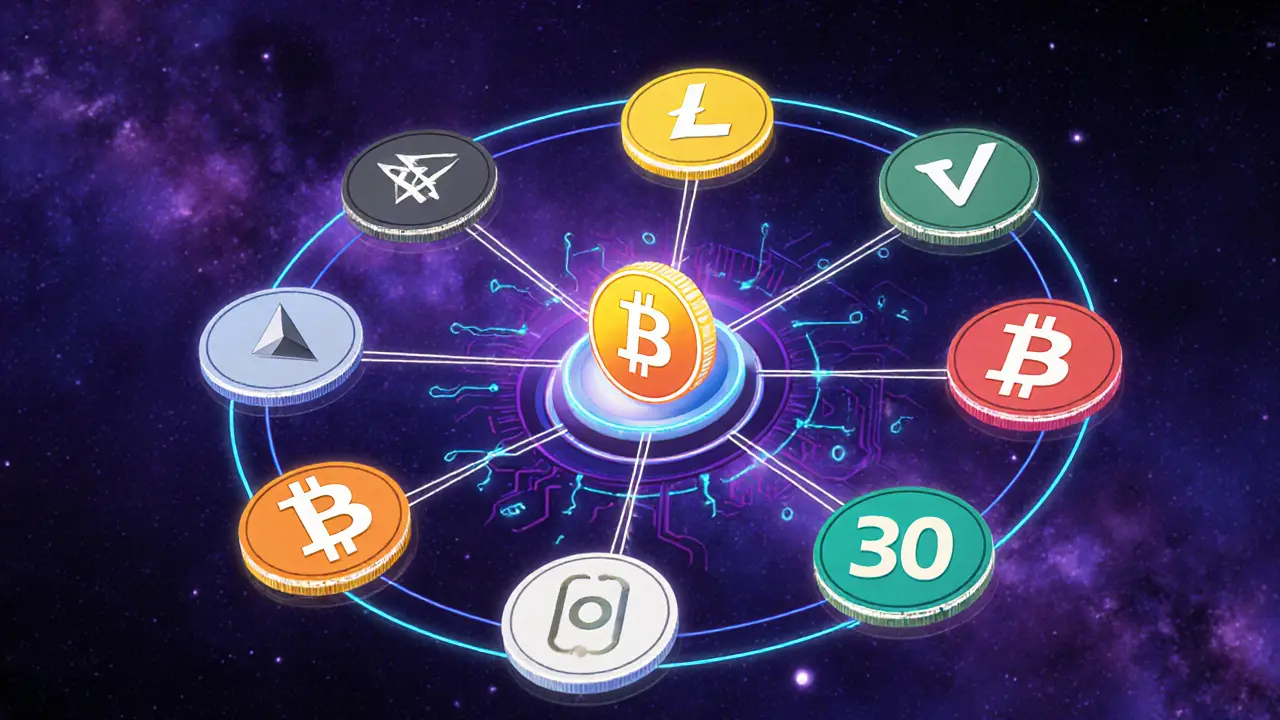Balancer Liquidity Earnings Calculator
How It Works
Calculate your potential earnings from providing liquidity to Balancer pools. You earn:
- Trading Fees (0.0005% to 0.5% per trade)
- BAL Token Rewards (145,000 BAL distributed weekly)
Input Your Details
Your Estimated Earnings
Important Considerations
Balancer users have reported an average impermanent loss of 14.3% during market volatility. The protocol's gas costs (~185,000 units) may reduce net earnings. BAL token value does not directly correlate with protocol revenue.
Most people know Bitcoin and Ethereum, but if you’ve been exploring DeFi, you’ve probably heard of Balancer. It’s not just another crypto coin - it’s a whole system built to automate investing. And its token, BAL, isn’t just for trading. It’s the engine that keeps the whole thing running.
What Exactly Is Balancer?
Balancer is a decentralized exchange (DEX) that works like a self-managing investment fund. Unlike Uniswap, which only lets you trade two tokens at a 50/50 ratio, Balancer lets you create pools with up to eight different tokens, each with its own weight. Think of it like a mutual fund, but instead of a human fund manager, a smart contract does all the work.Here’s how it works: You put $1,000 worth of ETH and DAI into a pool set at 70% ETH and 30% DAI. If ETH’s price goes up, the protocol automatically sells some ETH and buys DAI to bring the ratio back to 70/30. You don’t lift a finger. That’s called automatic rebalancing. And you earn a cut of every trade that happens in that pool.
It launched on Ethereum in September 2019. The team behind it - Fernando Martinelli, Nikolai Mushegian, and Mike McDonald - wanted to make it easier for everyday people to get exposure to diversified crypto portfolios without having to manually buy and sell every time prices shift.
How Does the BAL Token Work?
BAL is the native token of the Balancer protocol. It’s not a currency you use to pay for trades. Instead, it’s a governance token. That means if you hold BAL, you can vote on changes to the protocol - like adjusting fees, adding new features, or changing how rewards are distributed.
Every week, 145,000 BAL tokens are distributed to liquidity providers. The more liquidity you add to a pool, the more BAL you earn. As of October 2023, there are about 78.5 million BAL in circulation out of a max supply of 100 million. That means nearly 80% of the total supply is already out in the wild.
But here’s the catch: BAL doesn’t pay dividends or share protocol revenue. That’s a big reason why some analysts say its value hasn’t kept up with the protocol’s growth. Balancer has generated over $14 million in annual trading fees, but those fees go to liquidity providers, not token holders. So while BAL gives you voting power, it doesn’t directly give you cash flow.
Why Is Balancer Different From Uniswap or Curve?
Uniswap is simple. You swap two tokens. That’s it. Curve is built for stablecoins - think USDT, USDC, DAI - and offers near-zero slippage. Balancer is different because it’s built for complexity.
Here’s a quick comparison:
| Feature | Balancer | Uniswap v3 | Curve Finance |
|---|---|---|---|
| Max Tokens per Pool | 8 | 2 | 2-4 (mostly stablecoins) |
| Custom Weights | Yes (0.01% to 99.99%) | No (50/50 or concentrated liquidity) | No (fixed ratios) |
| Best For | Multi-asset portfolios, index funds | High-frequency trading, concentrated positions | Stablecoin swaps |
| Average Gas Cost | ~185,000 units | ~110,000 units | ~120,000 units |
| Slippage on Volatile Pairs | ~0.85% | Variable (can be low with good positioning) | ~0.04% (only for stable pairs) |
Balancer shines when you want exposure to a basket of tokens - like a DeFi index fund. For example, Index Coop used Balancer to create a pool with 10 metaverse tokens weighted by market cap. That’s something Uniswap can’t do. But if you just want to swap ETH for DAI quickly and cheaply, Uniswap or Curve are better options.

Who Uses Balancer?
It’s not just retail traders. Institutions are using Balancer too. Over 42% of its total value locked (TVL) comes from structured products like tokenized index funds, ETFs, and automated vaults. Companies like Yearn Finance, TokenSets, and Index Coop rely on Balancer to manage complex portfolios.
On the retail side, users who understand DeFi love the auto-rebalancing feature. One Reddit user reported earning 6.2% APY from trading fees plus BAL rewards by maintaining a 5-token portfolio through market swings. But beginners often struggle. The interface isn’t beginner-friendly. Creating a pool requires understanding token weights, slippage, and impermanent loss - concepts that can be overwhelming if you’re new.
According to user feedback, 78% of reviewers praise the multi-token functionality, but 63% complain about a poor mobile experience and confusing setup steps. The learning curve is real. One study found that new users need nearly 3 hours of tutorials before they can successfully set up a pool.
What’s New? Balancer V3 and Multi-Chain Expansion
Balancer isn’t standing still. In late 2023, the community approved the V3 upgrade, set to launch in early 2024. It introduces two major features:
- Linear Pools - These let you hold a single asset while still earning fees, useful for staked ETH or other liquid staking tokens.
- Boosted Pools - These integrate with liquid staking derivatives (like stETH or rETH) to give higher yields without extra risk.
Balancer has also expanded beyond Ethereum. It now runs on Arbitrum, Optimism, Avalanche, and Polygon. But here’s the problem: liquidity is fragmented. Over 38% of Balancer’s TVL is now on layer-2 chains, but only 6.2% of trading volume happens there. That means most trades still happen on Ethereum - and gas fees are still high.
To fix this, Balancer’s treasury just launched a $5 million liquidity mining program on Arbitrum to incentivize more users to move their pools there.

Is Balancer Safe? Risks to Know
Like all DeFi protocols, Balancer isn’t risk-free.
- Impermanent Loss: If one token in your pool swings wildly in price, you can lose money compared to just holding the tokens. During the 2022 crash, Balancer users saw an average impermanent loss of 14.3% - better than Uniswap’s 22.7%, thanks to diversification.
- Gas Fees: Balancer’s complex math means higher gas costs. You’ll pay more per transaction than on Uniswap.
- Regulation: The SEC has cracked down on similar protocols. Balancer already blocks users in 17 countries, including the U.S., to avoid legal trouble. Pools with more than three tokens could be seen as unregistered securities.
- Token Value: BAL’s price hasn’t kept pace with protocol revenue. The token has no direct revenue share, and inflation from weekly rewards has diluted its scarcity.
Still, the protocol’s code has been audited multiple times, and there have been no major exploits. The real risk isn’t hacking - it’s complexity. If you don’t understand what you’re doing, you can lose money.
Should You Use Balancer?
Here’s who should use it:
- You want to automatically hold a diversified portfolio of crypto assets.
- You’re comfortable with DeFi and understand impermanent loss.
- You’re interested in governance and want to vote on protocol changes.
- You’re not just looking for quick swaps - you’re thinking long-term.
Here’s who should avoid it:
- You’re new to crypto and don’t know what a liquidity pool is.
- You only want to swap ETH for USDC quickly and cheaply.
- You’re expecting BAL to make you rich without effort.
Balancer isn’t for everyone. But if you’re ready to go beyond simple trading and treat crypto like an investment portfolio, it’s one of the most powerful tools in DeFi.
Is Balancer (BAL) a good investment?
BAL isn’t a traditional investment like stocks or bonds. It doesn’t pay dividends or share profits. Its value comes from governance power and speculation. If you believe Balancer will grow as a platform for institutional DeFi products, then holding BAL might make sense. But if you’re hoping for quick price gains, you’re likely to be disappointed. The token’s value has lagged behind protocol revenue for years.
How do I earn BAL tokens?
You earn BAL by providing liquidity to Balancer pools. The more liquidity you add, and the longer you keep it there, the more BAL you receive. Each week, 145,000 BAL are distributed to providers across all qualifying pools. You can also earn trading fees from users who swap tokens in your pool - so you get paid twice: in fees and in BAL.
Can I use Balancer on mobile?
Yes, but it’s not ideal. You can access Balancer through wallet apps like MetaMask or Trust Wallet, but the interface isn’t optimized for small screens. Creating pools or adjusting weights is clunky on mobile. Most experienced users manage their positions on desktop. If you’re new, stick to desktop until you’re comfortable.
What’s the difference between Balancer and a regular crypto exchange?
A regular exchange like Binance or Coinbase acts as a middleman - you trade with them. Balancer is decentralized. You trade directly with liquidity pools, which are pools of crypto locked in smart contracts. There’s no company behind it. The rules are coded into software, and anyone can add or remove liquidity. That makes it more open, but also more complex.
Do I need to be a developer to use Balancer?
No, you don’t need to code. But you do need to understand basic DeFi concepts: wallets, gas fees, liquidity pools, and impermanent loss. If you’ve used Uniswap before, you can start using Balancer. Just take your time. Use their guides, watch tutorials, and start small. Don’t put in more than you’re willing to lose.


Post Comments (14)
balancer is kinda like a robot fund manager that dont get tired or drunk lol. i started with 500 usdc and now i got like 2x back just from fees + bal rewards. no need to check prices every hour.
the real win is multi-token pools. i have one with eth, link, aave, dai, and uni. it rebalances itself while i sleep. better than my old manual trading.
Anyone who thinks Balancer is 'easy' is delusional. You need to understand impermanent loss, slippage, and gas arbitrage before touching a single liquidity pool. Most retail users lose money because they treat DeFi like a slot machine. This isn't Robinhood.
I love how Balancer lets you build your own little crypto index fund-it’s like having a tiny Vanguard account but on blockchain! The fact that you can set weights like 60% ETH, 20% WBTC, 10% LINK, 10% DAI is just beautiful. And the new boosted pools? Pure genius. No more choosing between yield and flexibility. You get both now.
It’s not perfect-mobile is still a mess, and gas hurts-but the innovation here is real. I’ve been in DeFi since 2020, and this is one of the few protocols that actually feels like it’s building for the future, not just chasing hype.
While the technical architecture of Balancer is indeed sophisticated, one must consider the regulatory implications of multi-token pools potentially being classified as unregistered securities. The U.S. Securities and Exchange Commission has demonstrated increasing scrutiny toward decentralized finance instruments. This may significantly constrain future adoption within jurisdictionally sensitive markets.
Why are Americans always so obsessed with these 'decentralized' scams? Back in my day, you invested in real companies-not some guy’s smart contract that could vanish overnight. This whole thing is just gambling with fancy words. And now they’re pushing it on layer-2s? Please. Stick to stocks, folks.
i think balancer is kinda like a mirror for how we think about money… like, if you’re always trying to ‘rebalance’ your life, maybe this protocol just reflects that inner chaos? also, i think the word ‘impermanent’ is weird… like, isn’t everything impermanent? even money? even love? even this comment?
balancer v3 is the real deal. linear pools? boosted pools? they just turned liquidity provision into a passive income machine. i’m not even joking-my stETH pool is making more than my side hustle. people still don’t get it. it’s not crypto. it’s finance. with code.
They’re using Balancer to hide SEC violations. You think the $5M liquidity mining program is for users? No. It’s to mask the fact that Balancer is secretly a hedge fund disguised as a DEX. The 17 blocked countries? That’s not compliance-that’s evidence. They know what they’re doing is illegal. They just hope you don’t connect the dots.
India has better crypto exchanges than this. Why would anyone use Balancer when ZebPay gives you 12% APY on stablecoins with one click? This is overcomplicated for the masses. Also, BAL token? More like Boring Asleep Llama.
I just wanted to say thank you for writing this. I was so lost when I first heard about Balancer, but your breakdown made it feel approachable. I started with a 3-token pool last month and it’s already teaching me so much about market dynamics. I’m not rich yet, but I feel smarter-and that’s worth more than any APY.
BAL is a garbage token. Zero revenue share. 80% of supply already out. Weekly inflation. It’s a giveaway. Anyone holding it is either naive or a shill. The real value is in the liquidity pools-not this useless governance token. Stop pretending it’s an investment. It’s a lottery ticket.
Just use Uniswap. It’s faster. Cheaper. Simpler.
It is imperative to acknowledge that the structural inefficiencies inherent in Balancer’s gas consumption profile may render it economically nonviable for low-capital participants. The protocol’s computational complexity, while intellectually admirable, imposes prohibitive transactional overhead that undermines its accessibility.